Surface Grids & Lasers | Dev Update #6
Jun 23rd

Here’s our round six update on the development status of Surface Grids and Lasers. If you haven’t seen them yet, check out Dev Updates #1, #2, #3, #4, and #5.
This will be a smaller update than usual because we’re focusing our efforts on the last sprint for the new galaxies we’ve been working on. We hope you won’t have to wait long for their official release, but if you’re feeling impatient, you can check them out by opting into the experimental version.
A primer on Surface Grids for anyone not familiar:
It’s a feature we’re developing for Universe Sandbox that makes it possible to simulate values locally across the surface of an object. In effect, it allows for more detailed and accurate surface simulation and more dynamic and interactive surface visuals. It also makes it possible to add tools like the laser, which is essentially just a fun way of heating up localized areas of a surface.
Keep in mind this is a development log for a work-in-progress feature. Anything discussed or shown may not be representative of the final release state of Surface Grids.
Set Phases to Accurate
Our last dev update focused on the upcoming galaxies, but at the end we mentioned how Jenn, astrophysicist and Universe Sandbox developer, was working on vapor flow for the Grids model. We also joked that the challenging part here is creating this “accurately and performatively without single-handedly developing Weather Simulator 2020.” Unfortunately, the joke is all too real!
That doesn’t mean we are actually developing a complex weather simulator, but there is nonetheless complexity. While developing the vapor flow model, Jenn has been doing her homework with research into fluid systems and geophysics (if you’re looking for some light reading, you can check out Lectures On Dynamical Meteorology, Geophysical Fluid Dynamics, and An Introduction to Planetary Atmospheres).
The first part of vapor flow is determining what exactly is vapor; this is done by phase tracking, which determines what phase each material is in, based on temperature and elevation. For water, vapor is its gas state, then we need to see where it’s headed from there — whether it’s evaporating or condensing at the dew point, depositing, if it should be boiling away completely, etc. If it’s remaining as vapor, then the model accounts for a few factors to move it around: there are the prevailing winds which vary by latitude, are affected by planet rotation, and cause east-west movements (as seen in the GIF at the top), and there are temperature differentials from thermal flows and elevation that cause north-south movement (still a work in progress).
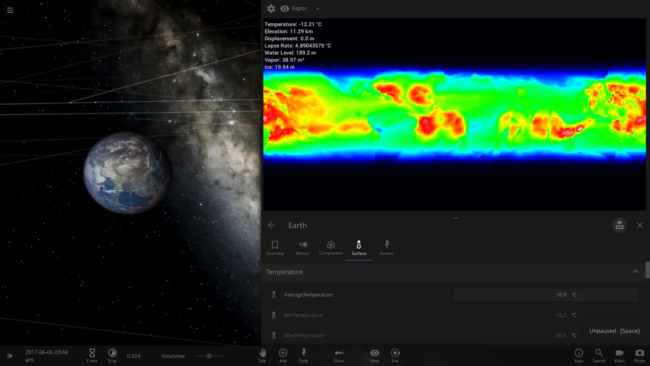
Image: The “heat map” shows vapor amounts (not vapor flow), where red is higher amounts and blue is lower. The poles are both much drier, and because there’s much less evaporation over land than oceans, you can see the outlines of the continents.
We want to stress that this is necessarily a very simplistic model, largely limited by its low resolution and the amount of memory we can allocate for this single component of Grids. There are lots of things missing that make this very different from more complex weather simulations — there are no vortices, so there won’t be anything like hurricanes, it is only a 2D simulation with no layers through the vertical dimension, and it’s fairly low resolution.
But we hope to use this data for the resulting local vapor amounts to have rough approximations for clouds, ice caps (for Mars, this effect happens with CO2 vapor flow), and for the future implementation of basic life simulation (vegetation), it could affect growth in dry and wet areas.
Loading…
In our last post, we also mentioned Chris’s work on saving and loading with Grids. This component of the feature obviously isn’t as interesting as, say, lasers, but at the same time, it’s essential to get it right and it’s another good representation of challenges on the edges of new feature development.
Here’s a shortlist of some of the questions and challenges that doesn’t even get into the technical weeds: How can we deal with file type and size limits for different platforms, like Steam Workshop, mobile devices, etc.? How can we maintain file size for fast, background autosaving and quicksaving? How can we get it to play nicely with previously saved simulations with objects that didn’t have all of the Grids data?
We had similar saving and loading questions with the new galaxies: What should happen if you load simulations that had the old galaxies? They won’t look and function the same. Should we change their shape and motion to use the new model, or should we preserve appearance? Is it okay to change sims on Steam Workshop that are very popular?
Saving and loading is something we all hope just works seamlessly and shouldn’t be something the player ever has to think about — which are both telltale signs that there is little room for bugs, errors, and bad user experience (UX). Thankfully, we have answers to all of these questions!
What’s Next for Grids
We’re hoping to make some good progress again on the visual side of Grids, rendering all of that wondrous data into some nice planet graphics. We’ve been recruiting our graphics developer, Georg, to work on some other projects (like the now so gorgeous galaxies), but it’s time for Grids attention again.
Thanks for reading! We’ll be back in two weeks with another update on development. And hopefully before that, we’ll have our next big update with new galaxies.

Dark Matter & Galaxies in Universe Sandbox
Jun 20th
You may notice that our new galaxy model (added in Update 23, released on June 25, 2019) no longer includes those bright red dots. The dots were how we represented dark matter in the old galaxy model (pre-Update 23), but we’ve decided not to include dark matter in the new model, for a number of reasons.
Short Explanation
Here’s the TL;DR explanation of why we removed dark matter in our new galaxy model:
Dark matter is a theoretical particle proposed to explain the unexpected motion of stars in galaxies. Due to performance constraints, our simplified galaxy dynamics model can’t simulate these complex orbits, so we’ve decided to remove dark matter from our simulations for now.
If you’re looking for a more in-depth explanation, keep reading!
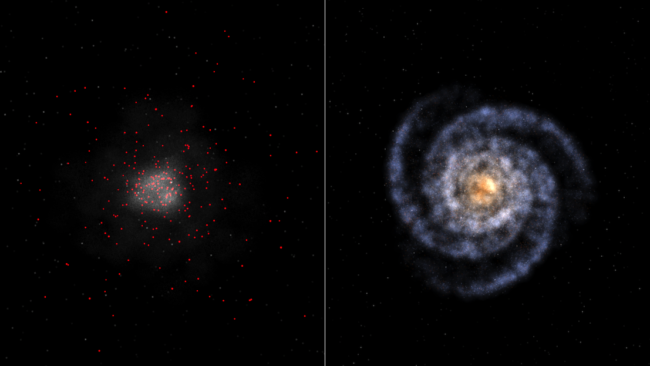
Left: Spiral galaxy with dark matter (pre-Update 23). Right: Spiral galaxy in Update 23.
What is dark matter?
No one knows for sure what dark matter is, or even if it exists! But a number of different observations of our universe have revealed stars and galaxies moving under the gravitational influence of more mass than we can see. This hints at the presence of some kind of matter that affects stars and other bodies via gravity, but that can’t be observed directly. This proposed “dark matter” doesn’t produce light, but it also doesn’t block it, or we would be able to see it silhouetted against brighter stars and galaxies in the background (like we can see dust in the Milky Way).
We don’t know of a type of particle that has mass but that doesn’t interact with light, but a few ideas have been proposed. It may be a new type of particle that we haven’t discovered yet, and several ongoing experiments are trying to directly detect such a particle. Some scientists argue that dark matter does not exist at all, and that the “missing mass” in astronomical observations simply indicates that our mathematical description of gravity is not yet complete.
What does this have to do with galaxies?
Spiral galaxies were one of the first examples of the missing mass problem. Astronomers discovered the problem while calculating the “rotation curve” for these galaxies: a plot of the velocity of a star orbiting in the galaxy, versus the distance of that star to the center of the galaxy. The speed at which an object orbits in space is related to the mass of everything inside its orbit, and the distance to the center of the orbit. In the Solar System, nearly all of the mass inside a planet’s orbit is made up of the mass of the Sun, so the difference in speeds of planet orbits is due mostly to their distance from the Sun. Thus, the rotation curve of planets in the Solar System starts with the high speed of Mercury’s orbit, and then drops off as you move outwards to Venus, Earth, and the rest of the planets.
But in a galaxy, most of the mass is distributed among the stars that make up the galaxy, so stars farther from the center are orbiting more mass than stars closer in. We can estimate the distribution of mass based on the stars that we see, and predict a slightly more complicated curve: First, the velocities of orbiting stars should increase as you move away from the center, as more and more mass is enclosed by the orbit. But eventually, the extra mass inside the orbit won’t be enough to make up for the increased distance from the center, and the velocities will start to decrease again. The predicted curve has a sort of hump shape, with a long, decreasing tail.
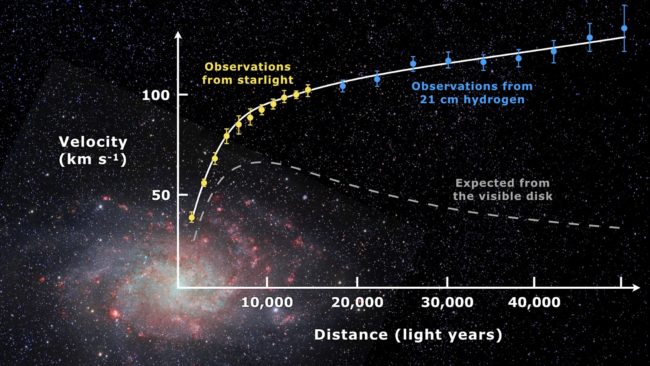
Rotation curve of the galaxy M33. The yellow and blue dots indicate the data, while the dashed line represents the curve you would expect based on the amount of visible mass in the galaxy. Instead, the velocity increases with distance, indicating that more mass is present than we can see. Credit: Mario De Leo
But when astronomers actually measure these velocities and create rotation curves of spiral galaxies, the curves don’t drop off with distance. Instead, the velocities get faster and faster as you move outwards, with stars on the outer edges moving so fast that you would expect them to fly off, pulling the galaxy apart. One explanation for this discrepancy is that some kind of unseen mass (“dark matter”) may be present in spiral galaxies, keeping those stars gravitationally bound to the galaxy despite their high speeds.
Dark matter in Universe Sandbox
Since Universe Sandbox is at its core a gravity simulator, we tried to show the influence of dark matter in our previous galaxy model. For a given galaxy, we would calculate the distribution of dark matter that we would expect based on real observations of galaxy rotation curves. Specifically, we used what’s called the Navarro-Frenk-White (NFW) profile, after the astronomers who identified the distribution. We simulated the dark matter as points of mass scattered through the galaxy, and displayed them as bright red dots (because dark matter is invisible, we wanted to make it clear that we weren’t showing what dark matter “really” looks like!).
This model would give the “right” distribution of dark matter in a galaxy, but it couldn’t reproduce the most important feature of dark matter in galaxies: the rotation curve. This is because of the way that galaxy simulation works in Universe Sandbox.
How galaxies are simulated in Universe Sandbox
In both the old and the new versions of our galaxy model, we represent the galaxy as a collection of non-attracting particles orbiting a single attracting body, the black hole at the center. Each particle represents a cloud of gas, dust, and stars, which we call a nebula. This means that to our physics engine, the nebulae have zero mass, and the only gravity in the galaxy comes from the black hole.
But wait, earlier we said that the mass in a galaxy is spread out among all the stars in the galaxy, instead of being concentrated in the center like the Solar System. Why don’t we make all the nebulae into attracting particles? This would certainly make the motion of the galaxy more accurate, but in any gravity simulator, the number of attracting particles significantly affects performance. (You can see this for yourself by opening a simulation with a lot of attracting bodies, like Earth & 50 Moons.) To make galaxies look as good as they do, we need to use hundreds or even thousands of nebulae. A simulation with a thousand attracting particles would run extremely slowly even on a very powerful gaming computer. So instead, we used a simplified model of non-attracting nebulae orbiting an attracting black hole.
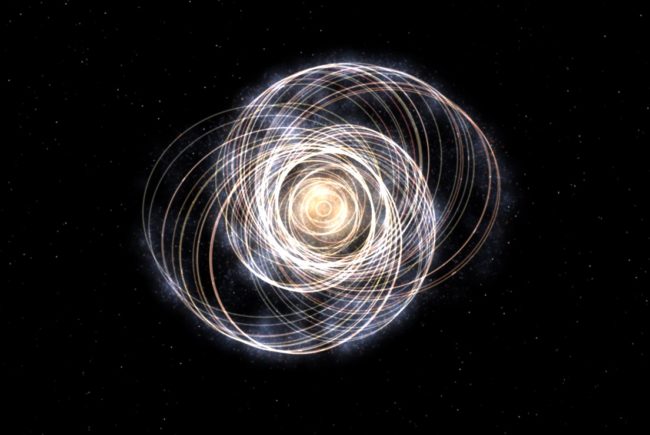
In the old version of galaxies, nebulae moved on circular orbits around the black hole, and the initial structure of a galaxy, whether it was a spiral or elliptical, would quickly lose its distinctive shape. In our upgraded version, nebulae are given specific orbits to allow the galaxy to hold its shape over time. The presence of another attracting body besides the black hole will pull the galaxy out of shape. (You can watch this happen in any galaxy collision simulation, or just by adding multiple galaxies to one of your own simulations!) During the development of this upgrade, we realized that adding attracting particles to represent dark matter would make it difficult to maintain the shape of spiral and elliptical galaxies for the same reason.
Because we are using a simplified galaxy model, we can’t reproduce the galaxy rotation curves we would expect either with or without dark matter. Instead, the rotation curves for our galaxies look more like the Solar System’s: the velocities of the nebulae drop off quickly as you move outwards from the center. Since this model can’t demonstrate the major effect of dark matter in galaxies, we decided to remove it for now.
We are hoping that a future version of galaxies will use computational methods like Smoothed-Particle Hydrodynamics (SPH) that will allow us to simulate hundreds to thousands of attracting nebulae orbiting the galaxy. This even more accurate model will be able to produce realistic galaxy rotation curves, and at that point, we’ll add dark matter back in so users can see its observable effect. In the meantime, we hope you enjoy our improved, interactive galaxy model!

Galaxies & Grids | Dev Update #5
Jun 7th

For this developer update, we’re going to take a little break from looking at our work on Surface Grids & Lasers to turn our attention on the upcoming new galaxies (these are a work-in-progress and are not yet available in Universe Sandbox).
You can check out Dev Update #1, Dev Update #2, Dev Update #3, and Dev Update #4 for a more in-depth look at Surface Grids & Lasers.
Keep in mind this is a development log for work-in-progress features. Anything discussed or shown may not be representative of the final release states for these features.
A Whole New World (of Galaxies)
We’ve been saying for a while now — and the community has been making sure to regularly remind us — that the state of galaxies in Universe Sandbox has not been so good. There was a pretty good looking preset simulation for a Milky Way & Andromeda Collision, but when it came to adding any type of galaxy to another simulation, you were left wondering why they all looked like the same amorphous blob, why they were difficult to work with, and what exactly all those red dots were.
Case in point, here’s a Milky Way added to a simulation with the old galaxies:

And here’s a new Milky Way:

We hope you agree this is a massive visual improvement. But there’s more than just beautification happening. Here are the major parts that make up the new galaxies:
1. Black holes & nebulae
- A galaxy is a combination of a black hole and a number of surrounding nebulae (each of which represents a group of stars)
2. Individual, editable properties
- Select and edit properties for black holes, individual nebulae, or the whole galaxy
- Each includes typical object properties like mass, radius, rotation, position, velocity, etc.
- Unique whole galaxy properties include galaxy type (elliptical, spiral, and irregular), elliptical B/A ratio, spiral number of arms, and pitch angle
3. Accurate motion
- Orbital elements of the nebulae are set by galaxy type and determine overall motion
- Nebulae positions and velocities change as galaxy type and type-related properties (B/A ratio, pitch angle, etc) are edited
- Galaxies in isolation will retain proper motion and shape over time
- Galaxies perturbed by massive bodies (like another galaxy or an isolated, supermassive black hole) become irregular type galaxies
4. Data-driven visuals
- Nebulae have a Gas Fraction property that represents the ratio of gas (the material available for making stars) to stars as well as an average temperature property
- Combined, these properties result in red/yellow elliptical galaxies, bluer spiral arms, and a visible increase in blue star production in colliding galaxies
- Nebulae also have a Dust Fraction property that represents the ratio of dust (opaque material) to gas and stars (luminous material); dust traces spiral arms and blocks light from the galaxy when viewed edge-on

GIF: Editable properties and the different visuals for different types of galaxies.
5. Procedural generation
- Create a randomly generated spiral galaxy, elliptical galaxy, or irregular galaxy
6. Support for trails & orbits
- Show trails or orbits for individual nebulae, which provides insight into realistic galaxy motion
7. No more dark matter
- Proper dark matter simulation is very complicated and we weren’t satisfied with its implementation in our last galaxy model
- In the future we’ll have a more in-depth explanation of this in a blog post from Erika, Universe Sandbox astrophysicist and developer behind the new galaxies
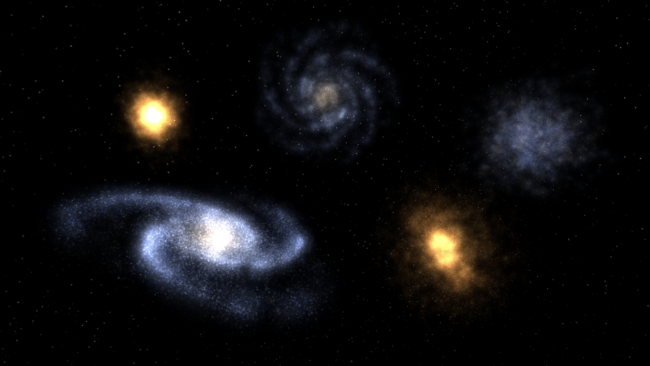
Image: A collection of randomly generated spiral, elliptical, and irregular galaxies.
The Future of Galaxies
We’re very happy with the status of galaxies right now. Before we can release them, there are some minor changes we need to make with the interface and other miscellaneous areas around the edges, and we still need a round or three of testing and bug fixes. But the simulation itself is in great shape.
When it comes to simulation features in Universe Sandbox, though, we almost never consider them a done deal. There are always improvements we have in mind for making them more realistic, performant, and fun to experiment with.
After the initial release of these new galaxies we’ll likely take a break from them for a bit. But here are some improvements and additions we’d love to explore more in the future:
- Barred spiral galaxies
- Visual representation of accurately-timed supernova flashes
- Values to show estimated numbers of stars in nebulae and total values in galaxy groups
- Randomization parameters for more “natural-looking” galaxies
- Run as fluid/SPH (smoothed-particle hydrodynamics) simulation
Surface Grids Sidebar
We’re hyped on galaxies and hope you are, too. Fingers crossed that the last stretch of finishing out this feature goes smoothly and quickly!
But of course, we’re also still working on Surface Grids & Lasers, so here’s a small update on those features:
Chris has been working on the saving and loading system for Surface Grids. This is a little less straightforward than it had been for saving and loading objects and simulations, due to the sheer amount of data that can be included with a lot of objects using the new Grids system.
Jenn has continued with making an accurate water vapor model, with the challenge of creating this accurately and performatively without single-handedly developing Weather Simulator 2020.
Georg has been applying his shader magic to galaxies and helping with proper rendering for Universe Sandbox on Magic Leap. Now that the graphics work for both of those are mostly finished, he’s got his eye on Surface Grids again as he continues to shape water data and heightmaps to get nice looking coastlines on Earth and other planets.
Stay tuned for another announcement about an opt-in version of Universe Sandbox that includes these new galaxies — we need to squash some of the nastier bugs still, but we’re getting close.
A Big Day for Physics | Update 22.3
May 30th
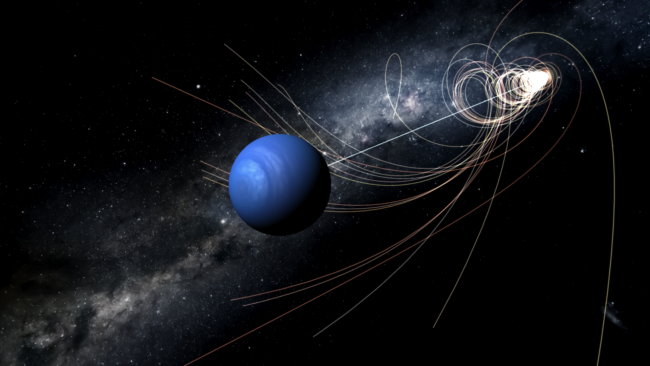
Run Steam to download Update 22.3, or buy Universe Sandbox via our website or the Steam Store.
This update officially switches over to our new physics system that is faster, more stable, and more accurate. This new system will be turned on by default, so there’s nothing you need to do to enjoy the improvement.
This update also includes a simulation commemorating an important historical date for physics: the 100-year anniversary of the total solar eclipse that was used to test and validate Einstein’s theory of general relativity.
Home > Open > The 100 Year Anniversary of the Eclipse That Validated General Relativity
General relativity is not simulated in Universe Sandbox, but even if it was, its effect would be hard to see. The difference in observed star position between Newton’s model and Einstein’s model is extremely small: about 1/2000th the width of the full moon.
Highlights from this update’s list of improvements and fixes:
- New Delete tool
- Reduced performance stuttering
- Smoother trails for fast-moving objects
- Fixes to updating Workshop sims
Please report any issues on our forums (local forum | Steam forum) or via Home > Send Feedback.
Check our a full list of What’s New in Update 22.3
We’re hiring a Graphics Developer! Learn more and apply
We’re hiring a Spaceship Physics Developer! Learn more and apply
Surface Grids & Lasers | Dev Update #4
May 24th


Image: Interface prototype for Surface Grids data map.
Time for our round four update on the development status of Surface Grids and Lasers. If you haven’t seen them yet, check out Dev Update #1, Dev Update #2, and Dev Update #3.
A primer on Surface Grids for anyone not familiar:
It’s a feature we’re developing for Universe Sandbox (meaning it’s not yet available) that makes it possible to simulate values locally across the surface of an object. In effect, it allows for more detailed and accurate surface simulation and more dynamic and interactive surface visuals. It also makes it possible to add tools like the laser, which is essentially just a fun way of heating up localized areas of a surface.
Keep in mind this is a development log for a work-in-progress feature. Anything discussed or shown may not be representative of the final release state of Surface Grids.
Interfacing
In this update, we’ll take a close look at a part of the new user interface (UI) for the Surface Grids feature, specifically the data map. While the UI doesn’t affect the Grids simulation itself, it determines how easy and seamless it is to view and interact with the Grids feature. And as with other features and the experience as a whole, it is the UI and its accompanying user experience (UX) that ultimately determine how accessible and enjoyable Grids will be.
In previous posts about Surface Grids, we’ve shared screenshots that show a floating panel with a Grids data map, like this:

We had been using this panel for debugging, but it was never a representation of our end-goal for its design. We strongly believe that floating panels (the kind that can be dragged around the screen and can overlap) in applications and games can be very cumbersome; while they offer a lot of flexibility, managing them can become a task in itself. So instead of actually playing the game, you spend most of your time resizing them and moving them around to make sure they’re not in the way of the gameplay or other parts of the interface.
So instead, we try to create an interface where you don’t have to think about panels at all — where they’re intelligently docked, organized, and out of the way.
Below is a prototype that shows the Surface Grids data map first located within the Properties panel, then popped out to a larger view, then docked to the left. The panel is then duplicated and switched to a graph.
Disclaimer as always: Anything discussed or shown may not be representative of the final release state. It’s also likely this end-goal design (which is subject to change) will be reached over multiple releases.

Iteration Behind the Scenes
Dan is the creator and director of Universe Sandbox and he also leads the way in designing its UI and UX. Recently, Dan started using Adobe XD, a tool for designing, prototyping, and collaborating on UI/UX for applications. It has already proven a valuable tool in UI iteration for Surface Grids.
Designing for UI/UX can be challenging in its early stages because it’s often hard to get a sense of how it feels to actually use it until you can literally use it. Some things might seem great in design, but once you program it in, you realize that it lacks a certain flow, or feels awkward next to other interactions, and then it’s back to the drawing board. XD’s ability to create an interactive prototype can cut out this need to implement the UI for testing, which means it’s also easy to give others on the team a sense of what the designer is imagining. All of this can make the iterative process of design and feedback a lot faster and more efficient. (And no, this is not sponsored by Adobe! But we do enjoy their tools.)
Check out the interactive version of the prototype shared above: Interactive Surface Grids UI Prototype
This is very simplified and intended to only show new parts of the interface. You can click anywhere on the screen to highlight in blue the areas that can be clicked.
And here’s a behind the scenes look at Dan’s Adobe XD workspace for the above interactive prototype (large row on the right) and some other prototypes. Each rectangle is a different view of the UI, essentially creating interaction through branching paths triggered by click-areas.
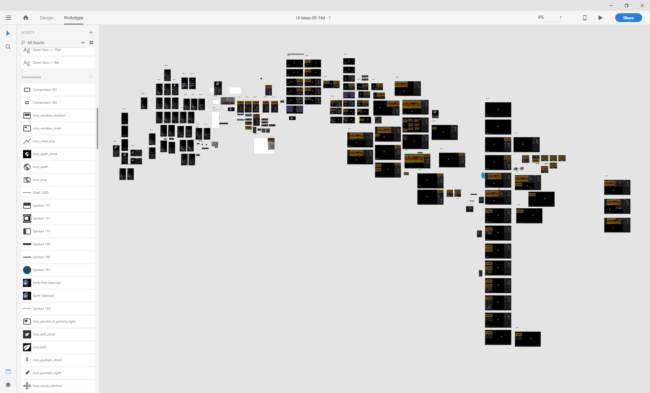
What’s Next for Grids
We can appreciate that showing the UI may not be as flashy as a GIF of a molten Earth, but we’d like to show how much work and iteration, from all different sides, goes into a single feature.
Chris is continuing to work on the technical implementation, Jenn is working through the science, and Georg is gussying it all up — we’ll back in two weeks to take another look at our progress.
Bonus Galaxy Preview!
We’re really looking forward to Surface Grids, but let’s not forget the new galaxies that are coming. Here’s a preview showing some recent visual upgrades and the ability to see orbital paths for the individual galaxy particles.

Surface Grids & Lasers | Dev Update #3
May 10th

Image: Early work on visualizing Grids data on a partially molten Earth, pre-beautification.
Here’s our round three update on the development status of Surface Grids and Lasers. If you haven’t seen them yet, check out Dev Update #1 and Dev Update #2.
A primer on Surface Grids for anyone not familiar:
It’s a feature we’re developing for Universe Sandbox that makes it possible to simulate values locally across the surface of an object. In effect, it allows for more detailed and accurate surface simulation and more dynamic and interactive surface visuals. It also makes it possible to add tools like the laser, which is essentially just a fun way of heating up localized areas of a surface.
Keep in mind this is a development log for a work-in-progress feature. Anything discussed or shown may not be representative of the final release state of Surface Grids.
Visualize It
In our last update, we talked about getting the new technical framework set up and working on the scientific-data side of Grids. In this update, we’ll focus on the third primary component of this feature: the visuals.
We can divide this visual component again into two separate challenges: 1) rendering the data accurately and 2) making it look good with visual magic.
Right now, our graphics developer, Georg, is working on the first part, rendering the data accurately. We talked before about the importance of getting the data right, but that’s really just the first step toward Grids as an accurate and interactive feature. The 2D data map that simply color-codes the data looks neat, but the first thing you see, and the thing most people want to look at, is the planet itself. So accurate data becomes much less useful if it’s not accurately represented in the planet visuals.
Visually representing this data is another tricky process. At its most basic, we need to nicely blend each possible material (silicate and water) with each of their possible phases (solid, liquid, and gas), as determined by elevation and temperature data. But it gets even more complicated: we need to account for elevation slope, the fact that phases aren’t just on or off but can exist somewhere in between (like partially-molten silicate), and the very likely possibility that seemingly opposite materials and phases can exist right next to each other (think of a high-powered laser melting ice).
From Coast to Coast

Another big challenge is working with the difference in resolutions. The Grids data is a low resolution compared to the visual resolution we expect for planets, especially ones that we are very familiar with, like Earth or Mars.
One good example is coastlines. In the GIFs above, take a look at the shimmering squares in the oceans. Each square is a point of Grids data. Compare that to the coastlines. If their outlines followed the same resolution, the continents would look more like a LEGO creation than the masses of land with all their nooks and crannies we’re so familiar with. We use a high-resolution heightmap for Earth, which works pretty well for accurate coastlines and large lakes. But the tricky part is getting this to play nicely with our lower resolution Grids data, so that only part of the Grids cell shows water and the other part shows land, i.e. accurate coastline.
All this talk of complex challenges makes it sound like this is difficult work. It sure is. But since this is a rewrite of Grids, we’ve done a lot of the heavy lifting already. Not to say it’ll be a walk in the park, but we at least have a good sense of what we’re up against.
Keep in mind these GIFs and screenshots represent works-in-progress and are tuned more to our current needs for development and debugging than they are for your viewing pleasure. All of this can and will change!
What’s Next for Grids
This has been another good couple of weeks for Grids development. There’s still plenty to do with getting the visuals right, plus eventually we have to turn our attention away from our favorite planet, Earth, to take a look at Mars and other randomized, generic planets and bodies.
Then once we start seeing all the data reflected accurately in the visuals, Georg will begin beautifying it with lighting, normal mapping (for bumps and dents), glows, etc, all the while multitasking with his work on the new galaxy visuals (read more about our work on new galaxies).
Here’s a glimpse of some preliminary graphics magic that demos improved lighting and emphasized normal maps (look at those ridges!), plus a bonus peek at part of our Unity development environment.
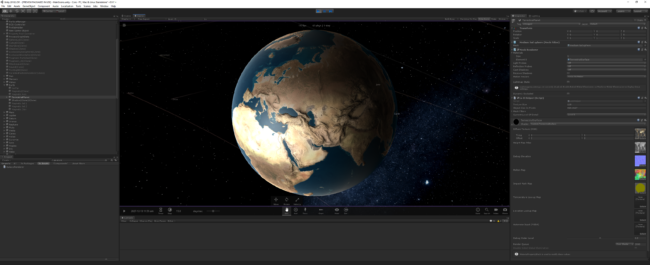
Thanks for reading! We’ll be back in two weeks with another update on Grids development.
Until then… did you know we started an official Discord for Universe Sandbox? Join us on Discord
All this graphics talk making you think it’d be a lot of fun to work on problems like these? Good news, we’re hiring a graphics developer! Learn more & apply
New Look, Same Great Sandbox
May 8th

UPDATE (March 2020): We completely removed the 2 from our application name as of Update 25. This required data folders to be renamed from “Universe Sandbox ²” to “Universe Sandbox”. If you need help with this change, please see our support page on this topic.
In Update 22.1, released in December 2018, we included a new logo (above) in the main menu of Universe Sandbox. The design is a small evolution of our last logo, but most importantly, we removed the 2 exponent. We’re no longer calling it Universe Sandbox ². Now it’s just Universe Sandbox.
We’re continuing to make this name and logo change everywhere we appear across the web. It’s a small distinction, but our reasons for changing it are significant:
1. It was confusing to say
Was it “Universe Sandbox Squared”? Or was it “Universe Sandbox Two”? Up to you!
2. It was hard to type
Do you know how to type a ² on your keyboard? No? Most of us didn’t either. And it was rare that YouTubers, journalists, or anyone else talking about Universe Sandbox would bother to find out how instead of just typing a normal “2.” We don’t blame them.
3. And most importantly, Universe Sandbox is here to stay
Sometimes people ask us when Universe Sandbox 3 is coming. Naming confusion aside, this is their question: when is a new version of Universe Sandbox going to be made? Our answer is that we have no plans for an entirely new version. There will be many more updates with new features, content, improvements, and bug fixes, but these are all planned for the current version of Universe Sandbox. Our roadmap stretches far into the future; we hope to continue to build, maintain, and research new technologies for Universe Sandbox so we can keep development going for a long time to come.
Universe Sandbox & Universe Sandbox Legacy
If you want to make your head spin, you can trace the history of the slight name changes that have been going on since the very first version of Universe Sandbox over a decade ago. (Here’s a sample: What we’re now calling Universe Sandbox was Universe Sandbox ², but when Universe Sandbox Legacy was called Universe Sandbox v2, before it was just Universe Sandbox, the now-called Universe Sandbox was actually referred to as Universe Sandbox 3, before being changed to Universe Sandbox ². Yep.)
But there are really only two things you need to know: There’s Universe Sandbox Legacy, which is the original Steam version released in 2011. And then there’s Universe Sandbox, which is the latest version now available on Steam Early Access, aka the version we hope you’ll be playing for years to come.
Universe Sandbox ² is dead. Long live Universe Sandbox!
Join the official Universe Sandbox Discord
Surface Grids & Lasers | Dev Update #2
Apr 26th
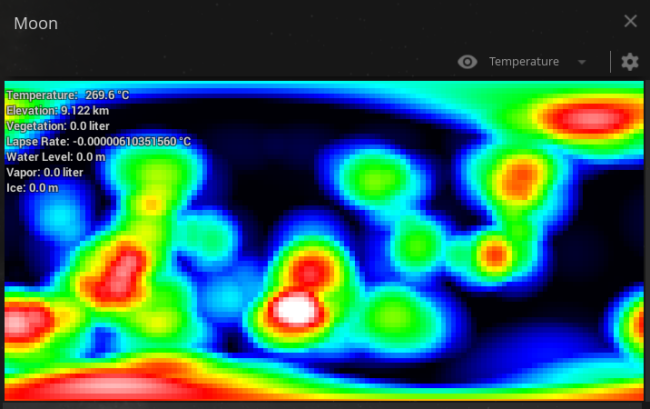
Image: A work-in-progress view of temperature data for the Moon’s surface during Bombardment of the Moon simulation
Here’s our round two update on the development status of Surface Grids and Lasers.
A primer on Surface Grids for anyone not familiar:
It’s a feature we’re developing for Universe Sandbox that makes it possible to simulate values locally across the surface of an object. In effect, it allows for more detailed and accurate surface simulation and more dynamic and interactive surface visuals. It also makes it possible to add tools like the laser, which is essentially just a fun way of heating up localized areas of a surface.
If you haven’t seen it yet, check out our blog post from a couple of weeks ago (we’ll call that Dev Update #1) where we talk about our decision to delay Surface Grids in favor of a rewrite that will better meet our Quality Standards for Awesome Features.
Keep in mind this is a development log for a work-in-progress feature. Anything discussed or shown may not be representative of the final release state of Surface Grids.
Getting Up to Speed
We’re happy with the progress that we’ve made so far on the new Surface Grids. We haven’t encountered any significant roadblocks (knock on wood) and the results we’ve seen are very promising.
Feature development in the beginning can be very exciting, because it can seem relatively quick to set up a framework, especially with a feature like this, where it’s a rewrite of a model we put a lot of work into. Early technical implementations can also give us a good sense of what’s to come and what is possible. At the same time, they can be a little less accessible from an outside perspective because they don’t have any of the polish and pizazz of a complete feature. At this point progress can also be a bit misleading, because often times the longest and most challenging part of development comes later, when we’re tweaking, polishing, finding and fixing bugs, and making sure all the complexities of the fully fleshed out model play nicely with each other and the rest of the simulation.
But let’s not get too ahead of ourselves — here’s a look at the progress we’ve made so far.
Zoom, Enhance!
As mentioned in our last post, concerns about performance with our old model played a significant part in our decision to do a rewrite. Performance relates directly to the resolution of the model: a higher resolution means more computations and slower performance. But the resolution of the model determines just how detailed the data and visuals can be, so a lower resolution model makes it that much less interesting.
The old model was scalable and the image below represents a fairly low resolution for the model, but it was also the baseline that we were working with because of performance concerns. In other words, we could run it at a higher resolution, but performance quickly took a hit once there were a bunch of objects in a simulation all running Surface Grids. Turning down the resolution helped, but not enough.
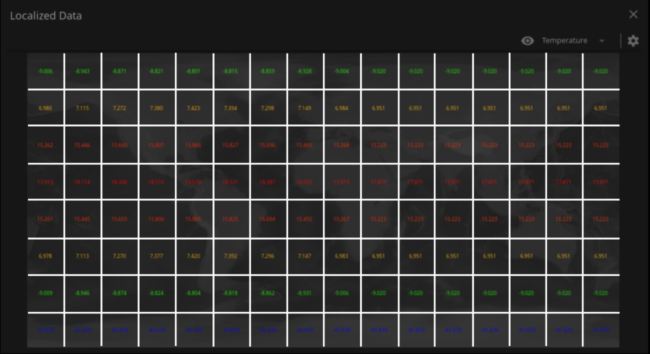
Compare that with the resolution of this new model, where each pixel is equivalent to a grid square in the above image.
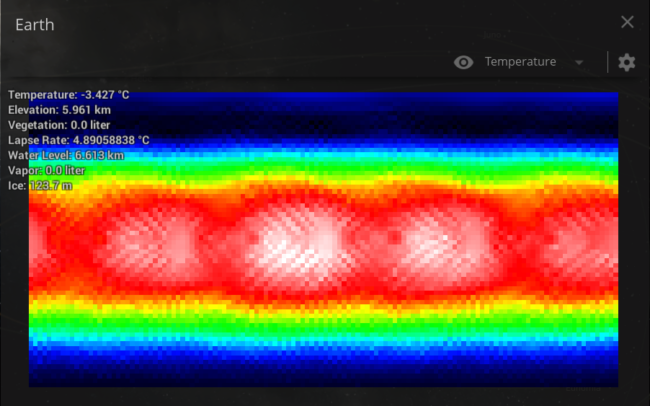
See the difference? Generally speaking, the new version of Grids is at least 100 times faster than the old version. Yes, that is much, much faster. And it makes us very, very happy.
This clip shows a data map of Earth’s temperature as it becomes tidally locked. And, importantly, there are also 99 other Earths in this simulation all running their own equally high-res Surface Grids model.

A big thank you to our lead developer, Chris, for creating this new, powerhouse version of Surface Grids.
Water World
There’s another new feature in this model that we didn’t have before: simulated water flow.
Currently water flow is affected by elevation, which in turn can be affected by impacts. Our wish-list for the future of Surface Grids includes elevation-editing tools, but right now we’re not expecting those anytime soon (including the first release version).
This clip briefly shows typical water flow on Earth (currently the model runs even while paused) before it’s affected by an impact with the Moon.

Water flow is a pretty experimental aspect of the model right now, so it’s especially likely this will change significantly as we continue development.
Getting the Data Right
We’d consider the whole of Surface Grids a wash if the data wasn’t based on science. But good news: it sure is based on science.
Jenn, Universe Sandbox astrophysicist and developer, has been busy getting all the data and numbers right in the technical framework. Sometimes a model will produce interesting and compelling results, but if the numbers aren’t based in science and the results aren’t showing what we’d expect to see for an accurate (though simplified) model, then it doesn’t meet our goals for a Universe Sandbox feature.
Building an accurate, generalized model for this is no easy task. It has to handle a range of materials (silicate, water, etc.) at different phases (solid, liquid, gas), all determined by other factors like elevation and temperature; each point has to interact with the rest of the grid, the rest of the Universe Sandbox simulation, and any user input; it has to run in real time; and in a normal state, it has to produce something that looks like the Earth or Mars we’re familiar with. Fortunately, this is well tread territory at this point, as Jenn solved a lot of these problems with the last model of Surface Grids.
What’s Next for Grids
We feel very good about the progress we’ve made so far and we plan to keep moving forward at this pace. We’ll continue with the technical implementation while also adding and double-checking the scientific layers of the model.
You’ll notice in the tidal-locking clip above that we only showed the data map, not the actual planet itself, as its local temperature shifted. That’s because there’s not much to see yet (compare to the visual state of the last model as seen in the last post). We love data, but we also love planet surfaces that look pretty and glow. The surface visuals are an important part of Surface Grids, and now that we have the technical framework laid out, it’s time to make it look good. Our graphics developer, Georg, is just getting started on these visual aspects, which are also based on his previous work on the old Grids model. We look forward to sharing his work in a future Grids posts!
Bringing the Magic of Universe Sandbox to Magic Leap
Apr 16th
Indie Creator Program
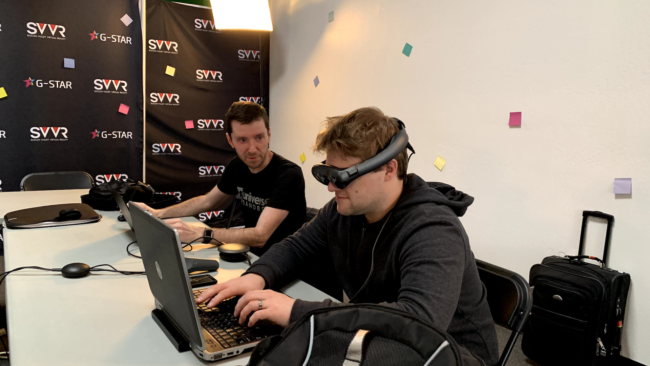
The news is out, we got a grant to develop Universe Sandbox for Magic Leap! Out of the 6,500 applicants that applied for Magic Leap’s Independent Creator Program, we were one of the lucky 30 that were accepted. We’re excited to join the company of other great indie developers and excited to bring the Universe Sandbox experience to Magic Leap.
If you’re not familiar, Magic Leap creates mixed-reality (MR) technology. Like VR, MR utilizes a headset and a motion-tracked controller for interaction. But unlike VR, the real world doesn’t disappear when you put on the Magic Leap headset. MR creates a map of the physical world around you and then superimposes digital images over it, bringing objects to life by making them appear like they are right there in front of you.
And with the mapping and object detection, the real world can interact with the digital world, allowing you to do things like smash planets against your wall.
Bootcamp
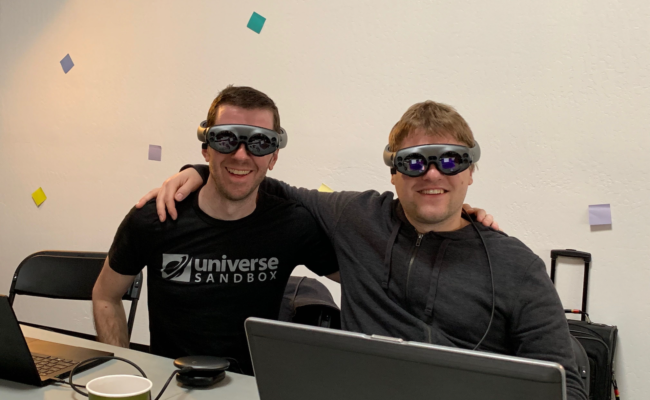
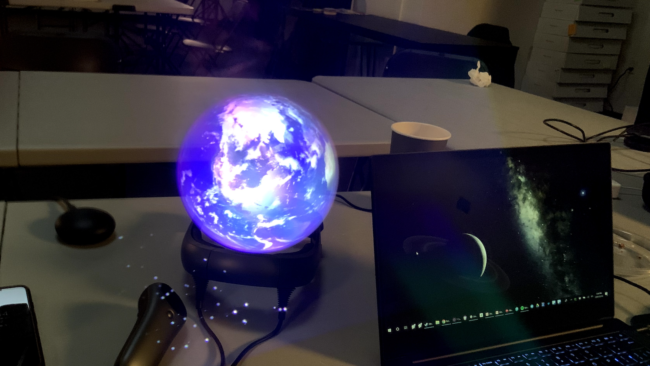
The very first step of development. Viewing Earth in Universe Sandbox through Magic Leap.
In February, Dan (Universe Sandbox creator & director) and Dave (Universe Sandbox mobile developer) went to California to attend the Magic Leap Creator Bootcamp. The Bootcamp was a crash-course in Magic Leap development, with discussions about the hardware, technical considerations, best design practices, and everything else creators like us need to know to make our magic happen.
It was an inspiring few days and a great opportunity for us to see what others are working on and what is possible for Universe Sandbox. We received some quality feedback on our plans as well as some exciting ideas for new directions.
Improving Universe Sandbox on Every Platform
Developing Universe Sandbox for Magic Leap is without a doubt exciting. But we don’t think about this development work as existing in a vacuum. While we continue to develop for desktop, we’re completely rewriting our VR interface, we’re polishing and optimizing for mobile, and we’ve now begun this work for Magic Leap. Further in the future, we’d like to do console versions, too. A key part of our vision for all of this is that the Universe Sandbox experience is never watered down. We want to make it possible to do the same things with Universe Sandbox in VR and on your phone that you already do on your desktop.
Of course, different platforms have different strengths and weaknesses; our design decisions are affected by these considerations for different hardware, different input, etc. But we can still aim for the power and flexibility that exists in the desktop simulation and interface.
Some of the design problems we face with Magic Leap will require developing solutions that improve all platforms. We expect the work we do on the interface will have a lot of significance for both the VR version and the mobile version that we are working on. And the performance optimizations we make while getting Universe Sandbox running on the Magic Leap headset will certainly have a ripple effect and improve performance on every other platform.
We look forward to sharing more about this journey as we continue development for Magic Leap!
What’s Next for Universe Sandbox | Spring 2019
Apr 10th
Delayed Gratification
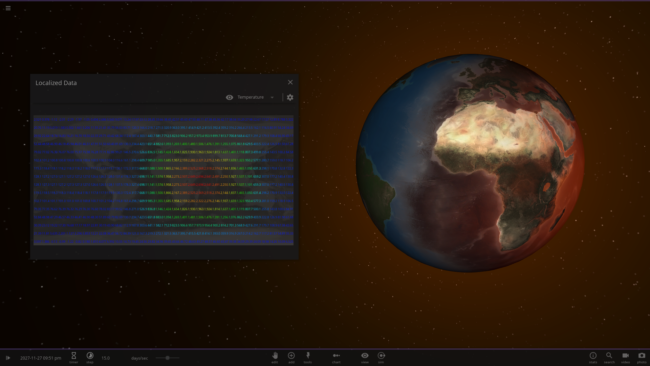
We know many of you have been patiently waiting for two of our next big features, Surface Grids & Lasers. We believe these features will be an awesome addition to the core Universe Sandbox simulation and experience, and we know from your excitement that you agree.
Not familiar with Surface Grids? It’s a feature we’re developing for Universe Sandbox that makes it possible to simulate values locally across the surface of an object. In effect, it allows for more detailed and accurate surface simulation and more dynamic and interactive surface visuals. It also makes possible tools like the laser, which is essentially just a fun way of heating up localized areas of a surface.
Short Version
If you’re a fan of treating bad news like a bandaid that needs to be ripped off, here’s the short version: We chose to further delay the release of Surface Grids & Lasers because our implementation was not meeting our expectations. We are now applying our work to a completely new approach that we think will be well worth the wait. We hope to have it ready this summer. Thank you for your patience!
And in the meantime, we hope to release some new simulation features: improved physics and new galaxies. Read more about these below.
Long Version
And if you’re curious, here’s the longer version: Last month we sat down for a team meeting on the status of Surface Grids and Lasers and had to make a difficult decision. The features weren’t quite living up to our expectations and standards. While we were continuing to make progress on development, we were also continually running into problems and were pushing the technical limitations of the system we had implemented, all with diminishing returns. We could either continue to work through all of the issues that remained and end up with something that met most of our high-level design goals but fell short on performance, or we could take everything we had learned and reimplement it in an entirely new system that would meet even more of our goals, be exponentially faster, bypass some of the issues we were trying to solve, and have much more room for future expansion. That makes it sound like a clear choice, but there were a couple of drawbacks: there were some technical compromises with this proposed new system, and pursuing it meant that we’d have to further delay the release of these features, something that we knew both we and our fans would not prefer. But after more discussion, we decided we didn’t want to compromise the quality of these features — let’s delay a bit, work on this better version, and release something that we’re very proud of. Please know that we are committed to new features and improvements and to the long-term future of Universe Sandbox development. We’re even expanding our team again — come join us as a Graphics Developer or Spaceship Physics Developer!
We can’t give a release date yet for Surface Grids & Lasers, but our plan moving forward is to provide an update every two weeks on their development. Below is a preview of what’s to come, showing a tidally-locked Earth close to the Sun where the back side freezes over and the near side becomes molten. And wait for the laser at the end!
Please note: the following image and the image at the top of this post are from the previous implementation of Surface Grids. We hope to go above and beyond what can be seen here for our new implementation, but the feature is subject to change and these may not be representative of its final state.

Improved Physics & New Galaxies
While we all wait as patiently as possible for Surface Grids and Lasers, we hope to deliver on two other features that have also been a long time coming: 1) a new, faster, and more stable physics system and 2) brand new galaxies.
Faster & More Stable Physics
The new physics system actually followed a similar development story as the one above about Surface Grids. After a long time spent working on the new system, the bulk of it was finished but stubborn issues stood in the way of its release, and new ones seemed to pop up every week. Eventually, we decided to cut our losses and run with a brand new system that was suddenly feasible thanks to some new Unity technology. Turns out this was a great move — we already have an experimental version of this new physics system available in Update 22.2 (learn more about trying it out). We hope to have the remaining kinks worked out soon so we can release it officially and get to work on some exciting new physics features again.
Brand New Galaxies
We also have already made great progress on a rewrite of galaxies, finally showing them the love that they have long deserved. These new galaxies will be much more varied, more interactive, and more accurate in simulation and appearance. The GIFs below do not show the latest visual changes, but they do a great job of showing how much more dynamic these galaxies are.
They will allow real-time editing of their properties, just like with any other object in the simulation:

And here you can see a series of procedurally generated galaxies added to a simulation:

We’re super proud of how galaxies have been shaping up so far. They’re impressive technically, scientifically accurate, fun to play with, and they’re looking pretty good, too. That checks all of our boxes for a quality Universe Sandbox feature. We look forward to sharing them in the future.
